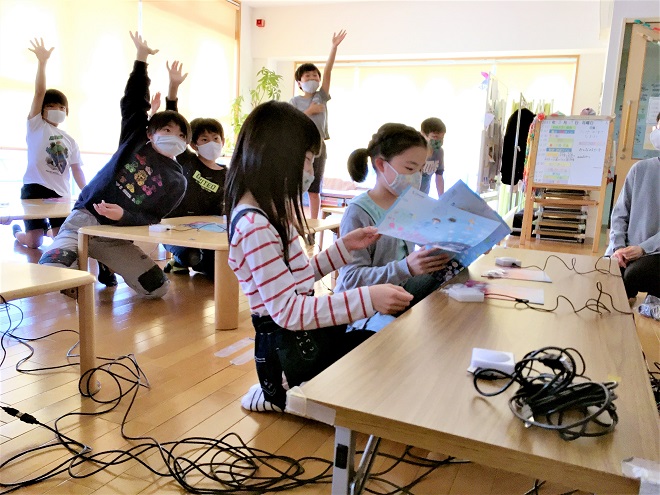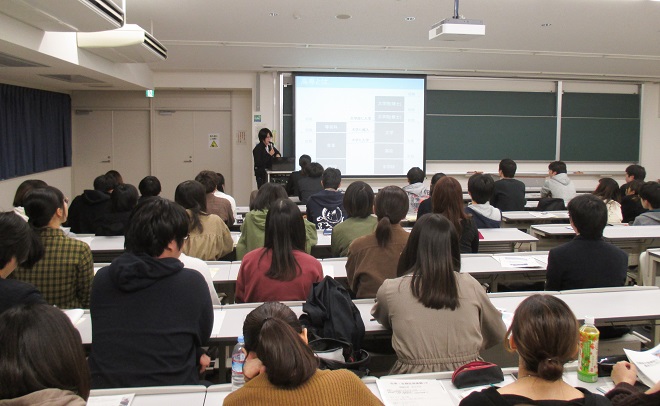Hiring targets, eased rules used to narrow gender gap in Japanese academia

Children take a push-button quiz at the Poppins After-School care center of Nagoya University. – Credit: Poppins After-School
In Japan, the academic gender-gap is wide. But some of the top universities in the country are taking strong steps to tackle inequalities and attract more female scholars.
By Nami Sugiura, Asahi Shimbun (Japan)
Nagoya University, considered one of the top universities in Japan, has been leading the academic world in helping female researchers avoid having to give up their careers because of pregnancies, parenting activities and other gender-related “obstacles” for years. Now, it is taking its long-term commitments to a whole new level, introducing hiring targets and enhancing the services for child care to further narrow its gender gap.
In the country, fewer women than men work in academia. And even fewer hold senior positions. One of the reasons is that young female researchers are often hired on limited-time contracts, giving them less time to produce the same results as their male counterparts in order to get contract renewals or staff positions.
The university, located in the city of Nagoya, the fourth largest in Japan, became the first in the country to set up, in 2009, an after-school child care center within its campus, after female academics with children of elementary school age complained about the “first-grader barrier.” Parents can send younger children to daytime nurseries, but facilities that look after elementary school pupils have shorter operating hours, making it difficult for their working parents to arrange their schedules. 77 elementary school pupils of all ages are currently registered at the campus daycare centre, which runs until 9 p.m.

A teacher at Gunma University’s School of Science and Technology encourages students to attend graduate school. – Credit: Gunma University
Employment targets
Women have accounted for around 17.5% of the university’s teachers over the last few years, but now the institution has set to raise the female teacher ratio to 20% during the 2021 fiscal year. It has also imposed employment targets for each course and department, as well as economic incentives. Sections that hire more female permanent employees than the number who leave can receive bigger budgets from the school operator, whereas departments that do not achieve the university’s goals will have their budgets reduced.
Narie Sasaki, an associate professor of biology at Nagoya University who helped found the after-school care center as part of her efforts to allow women to continue working, stressed the significance of these hiring targets. “Allocating positions exclusively to women does not give women an improper advantage but aims to destroy invisible barriers,” she said.
Hiroko Tsukamura, vice president of Nagoya University, said the policy to slash budgets for sections that do not reach the goals was decided after incentive-oriented, less strict female employment encouragement measures failed to improve the ratio of women. “Opposition came from some, but we repeatedly held discussions with each division and approved the policy at the all-campus trustee meeting,” she said. “Exceptional academics should be selected regardless of gender. If the right people are picked for the positions, there should be more women in the research community.”
Gunma University, in the northern Kanto region of Japan, is also taking aggressive measures to narrow the gender gap. Instead of using one-time budgets for equal-rights projects, the university prepares long-term funding not only to help female researchers install their own labs but also to hire part-time assistants for parents with small children. It has also sought to hire only female researchers for recent openings in its male-dominated School of Science and Technology.
As a result, the number of permanent female professors rose from four in 2012, to 12 in 2019. The female student percentage in the doctoral course more than doubled during the same period, from 12% to 26%.
Rules lifted for parental leave
Another challenge for female researchers is the insufficient parental leave system. While young researchers must frequently renew their contracts to secure academic posts, many universities have labor-management agreements or in-house rules that prohibit staff from taking parental leave in their first year and in the last year-and-a-half of their tenures. This makes it impossible for those working under two-year contracts to take child care leave, while three-year temporary staff members can take only six months off to take care of their offspring. These rules have made academics think twice about having children.
Although the rules are based on the Japanese ministry of labor’s guidelines on fixed-term employment, they can be revised if employees and employers reach an agreement. The Nara Institute of Science and Technology (NAIST) abolished these rules last year, for instance, allowing its workers to take parental leave whenever they want during their employment periods. It took them only six months to review the rules after the issue was raised by young female academics. Under the amended rules, all temporary teachers are now eligible for a one-year parental leave.
The University of Tokyo scrapped the restrictions for child care leave for both permanent and temporary staff members in 2005. The university also runs six nurseries that accept new children every month.
Teruo Fujii, who became the university’s president in April this year, has emphasized its “diversity and inclusion.” More than half of the university’s new executives are women. They come from various backgrounds, including a private company and an international organization. Women also accounted for a record high 21.1% of new students this year. “Women being publicly incorporated into management has symbolic importance,” said Kaori Hayashi, VP at the university. “We will make the university a school that individuals in a range of positions will want to attend.” However, the university’s female teacher ratio —including female associate and assistant professors— remains as low as 13.7%, while around 90% of its professors are men.
Ms. Hayashi said both men and women in academia compete based on their achievements and they do not hope people get chosen “simply because they are women.” But she reaffirmed the significance of helping women in employment. “The gender gap [in the University of Tokyo] of one woman every nine men is too wide to ignore, and there is a possibility that hidden talents have yet to be unearthed,” she argued. “There will be more cases where the most talented person is hired and the individual happens to be a woman.”

This article is being published as part of “Towards Equality”, an international and collaborative initiative gathering 15 international news outlets to highlight the challenges and solutions to reach gender equality.




